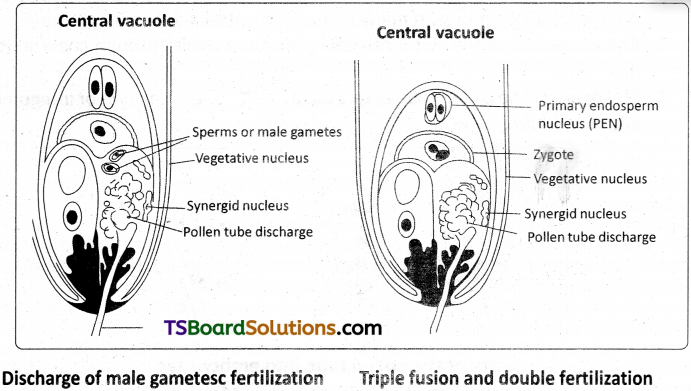Telangana TSBIE TS Inter 1st Year Botany Study Material 7th Lesson Sexual Reproduction in Flowering Plants Textbook Questions and Answers.
TS Inter 1st Year Botany Study Material 7th Lesson Sexual Reproduction in Flowering Plants
Very Short Answer Type Questions
Question 1.
Name the component cells of the “egg apparatus” in an embryo sac.
Answer:
- Three cells grouped together at the micropylar end of an embryosac are called egg apparatus.
- It consists of an egg cell and two synergids on either side of it.
Question 2.
Name the part of gynoecium that determines the compatible nature of pollen grain.
Answer:
Stigma of gynoecium determines the compatibility of pollen grains and promotes post pollination events that lead to fertilization.
Question 3.
Name the common functions that cotyledons and nucellus perform.
Answer:
- Both are nutritive in function and stores food materials.
- Cotyledons in seed provide nourishment for embryo, while nucellus of ovule nourishment for embryosac.
Question 4.
Name the parts of pistil which develop into fruit and seeds.
Answer:
- Ovary of pistil develops into fruit after fertilization.
- Ovules in the ovary of pistil transforms into seed during post-fertilization events.
Question 5.
In case of polyembryoxy, if an embryo develops from the synergid and another from the nucellus which is haploid and which is diploid?
Answer:
- Synergid is a haploid cell present in embryo sac, so it gives haploid (n) embryo.
- Nucellus is diploid tissue in ovule. So it produces diploid (2n) embryo.
![]()
Question 6.
Can an unfertilized, apomictic embryo sac give rise to a diploid embryo? If yes, then how?
Answer:
- Apomixis is an asexual reproduction that mimics sexual process.
- In some grasses and Asteraceae members, the diploid egg cell formed without reduction division develops into an embryo without fertilization.
Question 7.
Which are the three cells found in a pollen grain when it is shed at the three celled stage ?
Answer:
- In about 40% of angiosperms, pollen grains are shed at 3 – celled stage.
- In that pollen grain one vegetative cell and two male gametes (formed by mitiotic division in generative cell) are present.
Question 8.
What is self incompatibility?
Answer:
- Self incompatibility (self.sterility) is a genetic mechanism that prevents self pollen from fertilizing the ovules by inhibiting pollen germination or pollen tube growth in the pistil. E.g : Abutilon.
- This is a mechanism to promote cross pollination and to avoid self fertilization.
Question 9.
Name the type of pollination in self-incompatible plants.
Answer:
Gross pollination.
Question 10.
Draw a diagram of a mature embryo sac and show its 8 – nucleate, 7-celled nature. Show the following parts : antipodals, synergids, egg, central cell, polar nuclei.
Answer:
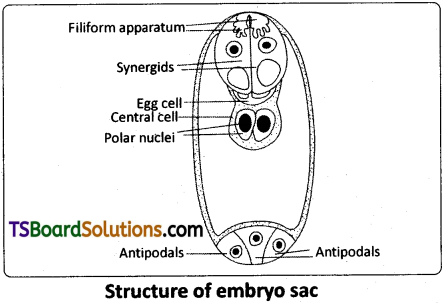
Question 11.
Which is the triploid tissue in a fertilized ovule? How is the triploid condition achieved?
Answer:
- Endosperm.
- One of two male gamete released from pollen tube unites with secondary nucleus (formed by the union of two polar nuclei) to from triploid endosperm.
Question 12.
Are pollination and fertilisation necessary in apomixis? Give reasons.
Answer:
- No, Apomixis is a form of asexual reproduction seen in some species of
Asteraceae and grasses. In those plants diploid egg cell is formed without – reduction division and develops into embryo without fertilization. - In many citrus and mango varieties, the nucellar cells surrounding the embryo sac start dividing, protrude into the embryosac and develop into the embryos.
![]()
Question 13.
How is pollination carried out in water plants?
Answer:
1) Epihydrophily :
Pollen grains reach the stigma of female flowers passively by water currents at the surface of water E.g: Vallisnaria.
2) Hypodrophily :
Pollen grains released inside the water reach the stigma of female flowers submerged in water, pollination occurs under water. E.g : Zoostera.
Question 14.
What is the function of the two male gametes produced by each pollen grain in angiosperms?
Answer:
- One of the two male gametes released from pollen tube unites with egg cell to form zygote (2x).
- Second male gamete released from the pollen tube unites with secondary nucleus to form endosperm (3x).
Question 15.
Name the parts of an angiosperm flower in which development of male and female gametophyte take place.
Answer:
- Male gametophyte develops in the pollen grain that are formed in anthers of androecium.
- Female gametophyte (embryosac) develops in nucellus of ovules formed in gynoecium (carpels).
Question 16.
What is meant by monosporic development of female gametophyte?
Answer:
- Monosporic development : Embryo sac develops from a single functional megaspore.
- Monosporic embryosac is 8 nucleate and 7 celled.
Question 17.
Mention two strategies evolved to prevent self-pollination in flowers.
Answer:
1. Dicliny :
Male and Female flowers : (unisexual flowers) are formed on same plant (Maize-monoecious) or on different plants (papaya-dioecious).
2. Heterostyly :
Styles in flowers of the same species are in different heights (Eg: Primula)
Question 18.
Why do you think the zygote is dormant for some time in a fertilized ovule?
Answer:
- Zygote divides after formation of certain amount of endosperm (nutritive tissue) from PEN is formed.
- This is an adaptation to provide assured nutrition to the developing embryo.
Question 19.
If one can induce parthenocarpy through the application of growth substances, which fruits would you select to induce?
Answer:
- Parthenocarpy refers to the fruit production without fertilization of the ovary. This phenomenon is used for commercial production of seedless fruits.
- Fleshy fruits (Grapes, Banana) in which seeds are not edible, can be selected for induction of parthenocarpy.
Question 20.
Explain the role of tapetum in the formations of pollen grain wall.
Answer:
- Tapetum is the inner most layer in anther wall. It nourishes the developing pollen grains.
- Tapetal cells secrete sporopollenin, a constituent in hard outer layer, (escine) . of pollen grain. Sporopollenin can withstand high temperatures, strong acids and alkali.
Question 21.
What is meant by scutellum? In which type of seeds is it present?
Answer:
- Cotyledon of monocots (Grass family) is called scutellum.
- In grass family, scutellum is situated towards one side (lateral) of the embryonal axis.
![]()
Question 22.
Define with examples endospermic and non-endospermic seeds.
Answer:
- Mature seeds of castor and coconut that consists of nutritive tissue for embryo (endosperm) are called endospermic seeds.
- In seeds of pea, groundnut, beans etc., endosperm may either be completely consumed by the developing embryo, before seed maturation, so they are called non-endospermic seeds.
Short Answer Type Questions
Question 1.
List three strategies that a bisexual chasmogamous flower can evolve to prevent self pollination (autogamy).
Answer:
The three strategies that a bisexual chasmogamous flower can prevent self pollination are
1. Dichogamy :
Androecium and gynoecium of a bisexual flower mature at different times. This mechanism promote cross pollination by preventing self pollination in bisexual flowers. It is of 2 types.
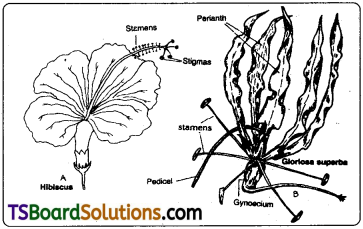
a) Protandry :
Androecium matures earlier than gynoecium. The entire pollen fall off from the stamens, by the time gynoecium matures.
E.g: Helianthus, Gossypium.
b) Protogyny :
Gynoecium matures earlier than androecium. Thus, by the time the gynoecium matures, the stamens remain in immature condition.
E.g: Solanum, Scrophularia.
2. Herkogamy :
The arrangement of male and female reproductive organs at different levels in a bisexual flower. This contrivancy prevents self pollination, though both the reproductive organs mature at the same time.
E.g : (a) Stigmas project beyond stamens in Hibiscus, (b) Stigmas bend in opposite direction to stamens in Gloriosa superba.
3. Self sterility :
In some bisexual flowers, the pollen grains fail to germinate on the stigma of the same flower. But the same pollen grains germinate, when they fall on the stigma of other flowers of the same species.
E.g: Abutilon, Passiflora
Question 2.
Given below are the events that are observed in an artificial hybridization programme. Arrange them in the correct sequential order in which they are followed in the hybridization programme.
a) Rebagging b) Selection of parents c) Bagging d) Dusting the pollen on stigma e) Emasculation f) Collection of pollen from male.
Answer:
i) Selection of parents.
ii) Emasculation
iii) Bagging
iv) Collection of pollen from male
v) Dusting the pollen on stigma
vi) Rebagging
Question 3.
Vivipary automatically limits the number of offsprings in a litter. How?
Answer:
- The plants which grow in Marshy places are called Mangrooves.
- These plants show Vivipary.
- Vivipary seeds germinate while they are still attached to the mother plant.
- Seeds when fall on Marshy places can not germinate because of high salinity and more water conditions. In these plants, seeds germinate when they are in mother plant.
So Vivipary automatically limits the number of offsprings in a litter.
![]()
Question 4.
Does self incompatibility impose any restrictions on autogamy? Give reasons and suggest the method of pollination in such plants.
Answer:
- Yes, self incompatibility impose restrictions on autogamy.
- The reason is this is a genetic mechanism. When the pollen grain falls on the stigma of the same flower it will not germinate. But when the same pollen grain falls on other flower it will germinate.
- The method of pollination in such plants will be only cross-pollination.
Question 5.
What is polyembryony and how can it be commercially exploited?
Answer:
- Development of more than one embryo in the same seed is called polyembryony.
- It is helpful in developing new varieties such as citrus and mango.
- The plantlets obtained from these embryos are virus free and has more vigour.
- Nucellar polyembryony is of great significance in horticulture. These embryos provide uniform seedlings of the parent type as obtained through vegetative propagation.
Question 6.
Are parthenocarpy and apomixis different phenomena? Discuss their benefits.
Answer:
Yes, parthenocarpy and apomixis are different phenomena.
Parthenocarpy :
The fruit production without fertilization of the ovary is called parthenocarpy. This phenomenon is applied for the commercial production of seedless fruits. E.g.: Banana, Grapes. This is more useful to juice industries.
Apomixis :
The seed production without fertilization is called apomixis. Production of hybrid seeds is costly and hence the cost of hybrid seeds becomes too expensive for the farmers. If these hybrids are made into apomicts, there is no segregation of characters in the hybrid progeny. Then the farmer can keep on using the hybrid seeds to raise crop year after year and he does not have to buy hybrid seeds every year.
Question 7.
Why does the zygote begin to divide only after the division of Primary endosperm cell (PEC)?
Answer:
- Primary endosperm cell (PEC) divides repeatedly to form endosperm.
- Endosperm is nutritive tissue.
- Zygote divides only after certain amount of endosperm is formed.
- This is an adaptation to provide assured nutrition to the developing embryo.
Question 8.
The generative cell of two-celled pollen divides in the pollen tube but not in a three-celled pollen. Give reasons.
Answer:
In over 60 per cent of angiosperms, the pollen grains are shed at two celled stage. They are vegetative cell and generative cell. After pollination, during germination, in the pollen tube the generative cell divides to give rise to two male gametes.
In the remaining 40 per cent of angiosperms, the pollen grains are shed at three celled stage. The reason is the generative cell divides to give rise to two male gametes before pollination.
![]()
Question 9.
Discuss various types of pollen tube entry into ovary with the help of diagrams.
Answer:
Entry of pollen tube into the ovule : It is of 3 types.
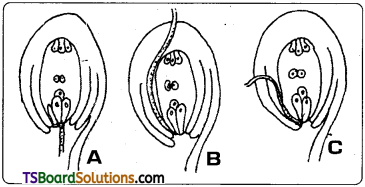
1. Porogamy :
The pollen tube enters into the ovule through the micropyle. It is the most common type in many plants. E.g : Ottelia, Hibiscus
2. Chalazogamy :
The pollen tube enters into the ovule through chalaza. It was discovered by Treub in Casuarina.
3. Mesogamy :
The pollen tube enters the ovule through funiculus or integuments. E.g: Cucurbita
Question 10.
Differentiate between microsporogenesis and megasporogenesis. Which type of cell division occurs during these events? Name the structures formed at the end of these two events.
Answer:
- Microsporogenesis is a process in which diploid microspore mother cells divide meiotically to form microspores.
- Megasporogenesis is a process in which diploid megaspore mother cell divides meiotically to form megaspores.
- Meiosis occurs during these events.
- Microspores and megaspores are formed at the end of these two events.
Question 11.
What is bagging technique? How is it useful in a plant breeding programme?
Answer:
Emasculated flowers are covered with a bag of suitable size. Generally made up of butter paper. This is called bagging. This is useful to prevent contamination of its stigma with unwanted pollen.
Question 12.
What is triple fusion? Where and how does it take place? Name the nuclei involved in triple fusion.
Answer:
- The second male gamete fuses with the secondary nucleus (formed by the fusion of two polar nuclei) of the embryo sac. This results in the formation of a triploid Primary endosperm nucleus (PEN). As this invovles the fusion of three haploid nuclei, it is termed triple fusion.
- Triple fusion occurs within the female gametophyte (embryo sac) of ovules.
- Nuclei involved in triple fusion are two polar nuclei of central cell and nuclei of male gamete.
Question 13.
Differentiate between
a) Hypocotyl and Epicotyl
b) Coleoptile and Coleorhiza
c) Integument and Testa
d) Perisperm and Pericarp
Answer:
| a) Hypocotyl | Epicotyl |
| The cylindrical portion of embryonal axis below the level of cotyledons is called hypocotyl. It is between radical and cotyledon. | The portion of embryonal axis above the level of cotyledons is called epicotyl. It is between plumule and cotyledons. |
| b) Coleoptile | Coleorhiza |
| The epicotyl has a shoot apex and a few leaf primordia enclosed in a hollow foliar structure called coleoptile. | The embryonal axis has the radicle and root cap is enclosed in an undifferentiated sheath called coleorhiza. |
| c) Integument | Testa |
| Protective envelope around the ovule is called integument. | After fertilisation, the outer integument of the ovule develops into testa. |
| d) Perisperm | Pericarp |
| Remnant nucellus present in the seed is called perisperm. | The fruit wall is called pericarp. |
![]()
Question 14.
What is meant by emasculation? When and why does a plant breeder employ this technique?
Answer:
Removal of anthers from the bisexual flower bud before the anther dehisces is called emasculation. It is done by forceps during bud condition. This prevents contamination of its stigma with unwanted pollen.
Question 15.
What is apomixis? What is its importance?
Answer:
- Production of seeds without fertilisation is called apomixis. It is a form of asexual reproduction.
- Apomixis do not involve Meiosis. Hence seggregation and recombination of chromosomes do not occur. Thus Apomixis help in preserving desirable characters for indefinite periods.
- Production for hybrid is costly. If these hybrids are made into apomixis, then the farmer can raise new crop year after year and he does not have to buy hybrid seeds every year.
Long Answer Type Questions
Question 1.
Starting with the zygote, draw the diagrams of the different stages of embryo development in a dicot.
Answer:
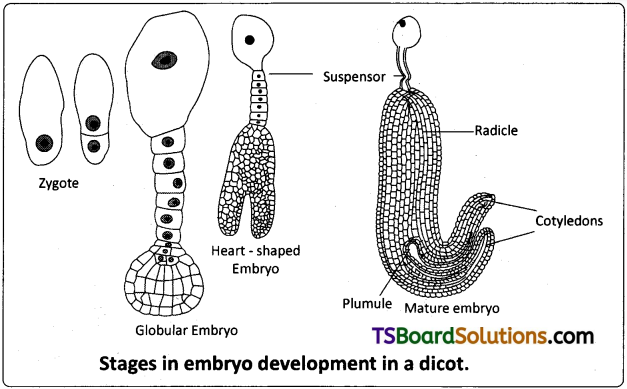
Question 2.
What are the possible types of pollinations in chasmogamous flowers? Give reasons.
Answer:
The flowers which open are called chasmogamous flowers. In these flowers self pollination or cross pollination may take place.
Self pollination –
The transfer of pollen grain from anther to stigma of same flower is called self pollination. The reason is the male reproductive organ (stamen) and female reproductive organs (carpels) mature at the same time. They lie side by side. This assures self pollination.
Cross pollination :
The transfer of pollen grain from anther to stigma of another flower is called cross pollination. It is 2 types.
i) Geitonogamy :
Cross pollination between two flowers of same plant is called geitonogamy. In this, there is no genetic variation, eg: Coeds nucifera (coconut)
ii) Xenogamy :
Cross pollination between two flowers of different plants belonging to the same species is called xenogamy. Eg : Borassus.
Continued self pollination results in inbreeding depression. So flowering plants have developed many devices or adoptations or contrivances to discourage self – pollination and encourage cross pollination.
![]()
Question 3.
With a neat, labeled diagram, describe the parts of a mature angiosperm embryo sac. Mention the role of synergids. [March 2019, ’17, ’14, May ’17]
Answer:
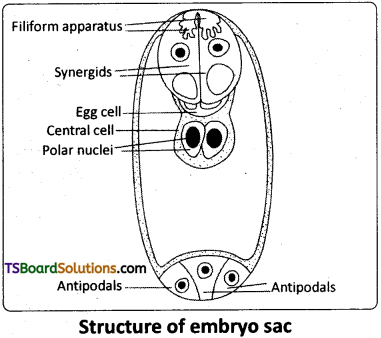
In angiosperms female gametophyte is called embryo sac. Embryo sac consists of three parts i.e. Egg apparatus, Antipodals and Central cell.
Egg Apparatus :
The three cells towards the anterior side are together called Egg apparatus. The middle big cell is called egg cell which acts as a female gamete. The two cells present on either side of the egg cell are called synergids.
Role of Synergids :
Synergids contain finger like projections called filiform apparatus, which help in absorption and conduction of food materials from nucleus into the embryo sac. They also help in directing the movement of pollen tube towards the embryo sac.
Antipodals :
The three cells present towards posterior side are called antipodals.
Central cell :
Central cell is the largest cell with central vacuole and two polar nuclei.
Question 4.
Draw the diagram of a microsporangium and label its wall layers. Write briefly about the well layers. [Mar. – 2020. 2018, May ’14]
Answer:
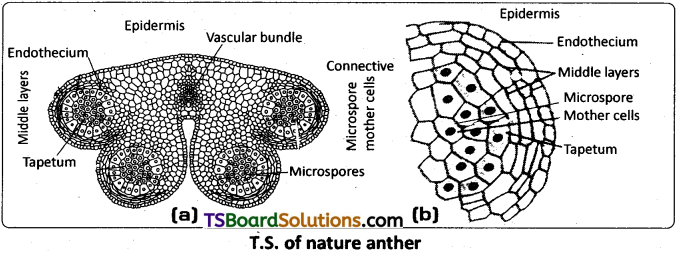
Anther wall consists of
- One cell thick outer protective layer, epidermis. The thin walled epidermal cells between two pollen sacs constitute stomium, which is useful for the dehiscence of pollen sacs.
- Endothecium, a layer of radially expanded cells present below the epidermis. These cells have hygroscopic fibrous thickenings of cellulose and help in the dehiscence of pollen sac.
- Middle layers present below the endothecium consists of 1 – 5 layers of thin walled cells.
- Tapetum is the innermost nutritive layer of anther wall, which encircles the sporogenous tissue. The cells in this layer are large, thin walled, bi – or multinucleate and nourish the developing sporogenous tissue.
Question 5.
Embryo sacs of some apomictic species appear normal but contain diploid cells. Suggest a suitable explanation for the condition.
Answer:
- Apomixis is a form of asexual reproduction that mimics sexual reproduction.
- In this method seeds are produced without fertilization.
- A few flowering plants such as some species of asteraceae and grasses have evolved a special mechanism to produce seeds through apomixis.
- In some species, the diploid egg cells is formed without reduction division. It develops into the embryo without fertilization.
- Apomictic method is an assured reproduction in the absence of pollinators, such as in extreme environments.
- Seeds produced by apomixis can be called as clones, because they are resulted from mitotic cell divisions and resemble the parent and also one another in all characters.
- In many citrus and mango varieties, some of the nucellar cells surrounding the embryo sac start dividing, protruds into the embryo sac and develop into the embryos. In such species each ovule contains many embryos. Occurrence of more than one embryo in a seed is referred to as polyembryony.
- Hybrid varieties of several of our food and vegetable crops are being extensively cultivated. This led to tremendous increase in productivity. But hybrid seeds are to produced every year, the progeny from hybridization may segregate and do not maintain characters. If the hybrids are made into apomictics, the farmer does not have to buy hybrid seeds every year.
- Because of the importance of apomixis in hybrid seed in dusty, active research is going on in many laboratories around the world to understand the genetics of apomixis and to transfer apomictic gene into hybrid varieties.
![]()
Question 6.
Describe the process of fertilisation in angiosperms.
Answer:
Fertilization :
- The fusion of male and female gametes is called fertilization.
- In angiosperms, female gamete is an egg cell and is present in embryo sac (female gametophyte).
- Embryo sac is embedded in the ovule which is present inside the ovary of gynoecium.
- Male gametophyte (pollen grain) produced in the anther reaches the stigma by pollination at 2 – celled stage.
- It germinates on the stigma and produces pollen tube, which grows into the style and reaches the ovule.
- In the pollen tube generative cell divides and produces two male gametes.
I. Entry of pollen tube into the ovule: It is of three types.
1. Porogamy :
The pollen tube enters into the ovule through the micropyle. It is the most common type in many plants. E.g: Ottelia, Hibiscus.
2. Chalazogamy :
The pollen tube enters into the ovule through chalaza. It was discovered by Treub in Casuarina.
3. Mesogamy :
The pollen tube enters the ovule through funiculus or integuments. E.g: Cucurbita.
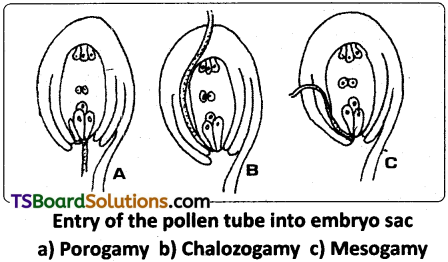
II. Entry of pollen tube into Embryo sac:
After the entry of pollen tube into the ovule, it enters into the embryo sac only through the micropylar region, either passing in between egg cell and , synergid or penetrating through synergid cell. The entry of pollen is directed by filiform apparatus.
III. Discharge of male gametes (sperms)into embryo sac :
The male gametes are released into the embryo sac by (a) bursting of pollen tube tip or f b) degeneration of the tip or (c) by the formation of an apical pore. The pollen tube finally releases the intact male gametes (cells) and vegetative nucleus.
IV. Gametic fusion :
According to many scientists, only the nuclei of male gametes migate out of them. But recent evidences suggest that the male cytoplasm is also involved in fertilization.
V. Triple fusion and Double Fertilization :
Syngamy :
One (first) of the sperm fuses with the egg cell and forms a diploid zygote. This fusion is called Syngamy or fertilization and was first discovered by Strasburger (1884). This is also called True or real fertilization.
Triple fusion :
The second sperm nucleus fuses with the secondary nucleus (formed by the fusion of two polar nuclei) of the embryo sac. This results in the formation of a tripioid primary endosperm nucleus (PEN). Hence it is called Triple fusion. It was discovered by Nawaschin in Lilium and Fritillaria. This is also called vegetative fertilization.
Double Fertilization :
In angiosperms, two male gametes released from the pollen tube take part in two fertilizations (Syngamy and Triple fusion). So, this phenomenon is called Double Fertilization.
